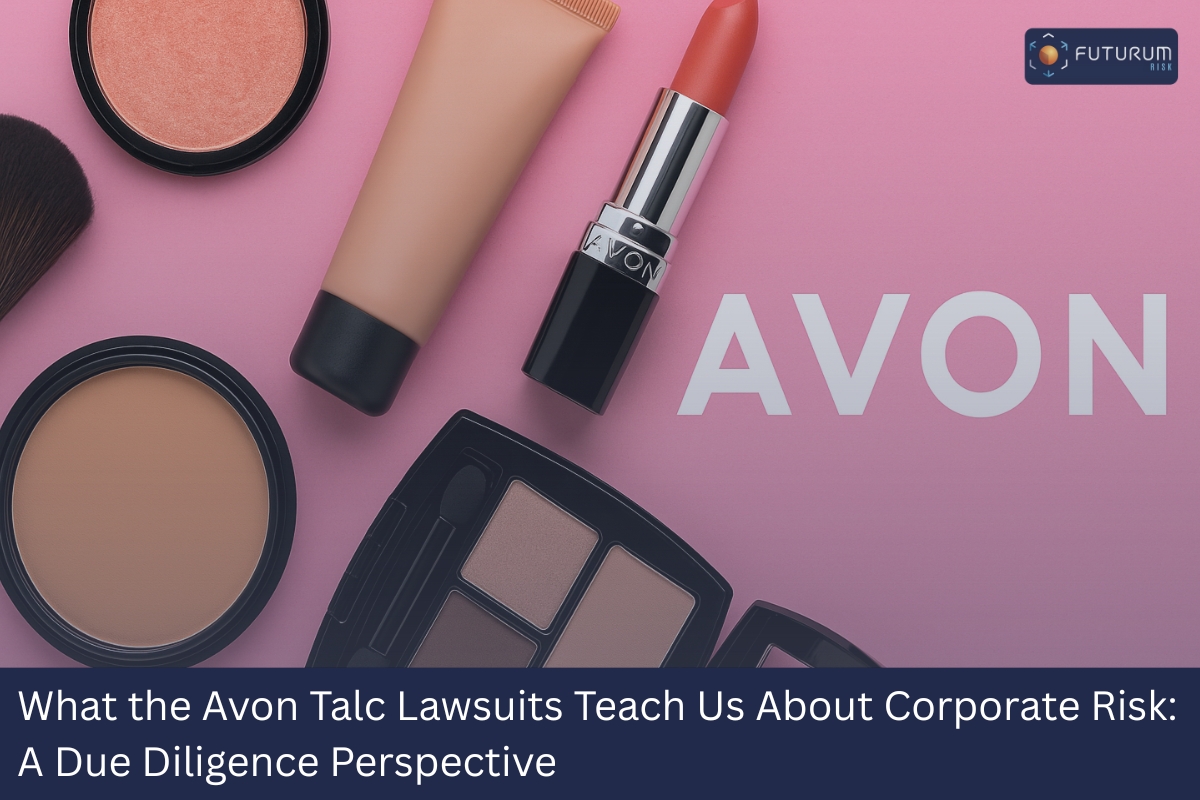When companies face lawsuits, public scrutiny, or financial trouble, the headlines rarely tell the full story. The real insight lies in how they behave under pressure, and that’s where due diligence becomes most revealing.
This blog looks at the Avon talc powder lawsuits as a case study in corporate risk. It explores what their decisions show about liability, reputation, financial health, and leadership behaviour, and why understanding those patterns is essential before investing, partnering, or doing business with any company.
What the Avon Talc Lawsuits Teach Us About Corporate Risk: A Due Diligence Perspective
When companies face serious litigation, reputational scrutiny, and financial distress, the real story is often not in the headlines; it’s in the patterns of behaviour behind them. At Futurum Risk, these patterns are exactly what we look for when conducting corporate due diligence and risk intelligence investigations.
The recent Avon talc powder case, involving asbestos-related class action lawsuits, accusations of misconduct, and a controversial bankruptcy filing, provides a textbook example of why due diligence matters. It shows how corporate decisions made under pressure can reveal deeper risks, and how those risks can influence investment decisions, partnerships, and strategic choices.
This blog explores how we would approach a case like Avon as part of a due diligence investigation, the risk categories we examine, and how what is unfolding in Avon’s situation aligns with the warning signs we are trained to detect.
Understanding the Avon Controversy
Avon, a global beauty and personal care company with over a century of history, is currently at the centre of one of the most significant product liability battles in recent years. The brand, long known for its cosmetics and skincare lines, is now facing hundreds of class action lawsuits in the United States over claims that its talc-based powders were contaminated with asbestos, a substance linked to cancers such as mesothelioma.
As these legal challenges mount, Avon has filed for Chapter 11 bankruptcy, a move that insurers and plaintiffs allege was made in bad faith to shield the company from paying full compensation. The case has quickly become a touchpoint in discussions about corporate accountability, crisis management, and how companies behave under intense legal and reputational pressure.
Inside a Due Diligence Investigation
A corporate due diligence report is not just a background check or a compliance exercise. It is a comprehensive investigation into the financial, legal, operational, behavioural, and reputational risks linked to a company and the individuals behind it.
At Futurum Risk, our investigations are designed to reveal not only what a company is doing now, but also how it is likely to behave when things go wrong. That behavioural dimension, how organisations respond to legal threats, financial pressure, regulatory scrutiny, or public criticism, is often the most revealing.
This is where our work becomes more than a process. Our niche lies in reading the human signals behind corporate activity. A company is, after all, a collection of people, and decisions made in boardrooms, under stress or scrutiny, are deeply human in nature. Understanding those dynamics allows us to see beyond policies and statements to the true risk culture that shapes an organisation’s actions.
A typical corporate due diligence investigation at Futurum Risk involves several key layers:
- Individual Risk Analysis – Examining the people behind the company: their history, conduct, associations, litigation records, and online footprint.
- Entity Risk Analysis – Investigating the company itself: corporate structure, ownership, regulatory standing, financial health, litigation history, and operational dependencies.
- Reputational and Behavioural Risk Analysis – Going beyond documents and disclosures to understand public sentiment, social media activity, crisis responses, and patterns of behaviour under scrutiny.
The Avon case provides real-world examples of how each of these layers reveals different aspects of risk.
1. Product Liability: A Critical First Layer
What we look for:
In any due diligence investigation, product liability risk is one of the earliest red flags we try to detect. This involves identifying the potential for a company’s products or services to cause harm, attract litigation, or trigger regulatory action. We assess the scale, severity, and nature of any liability, and crucially, how the company has handled it.
What we see in Avon:
This risk is not hypothetical. Avon is currently facing hundreds of class action lawsuits alleging that asbestos contamination in its talc-based products caused serious illness, including cancer. The scale of the claims, their historical depth, and the health consequences involved would all raise immediate concerns in a due diligence review.
We would analyse:
- The number and nature of claims, and the jurisdictions in which they are filed.
- Any evidence of negligence, concealment, or non-compliance with product safety regulations.
- How Avon’s litigation profile compares to competitors and industry norms.
- The potential financial exposure linked to settlements, judgments, or regulatory penalties.
Product liability issues of this magnitude are not just legal risks; they are indicators of broader cultural and operational weaknesses, often pointing to failures in safety oversight, corporate governance, or crisis management.
2. Reputational Risk: How Crisis Response Shapes Perception
What we look for:
Reputational risk is not measured by media sentiment alone. It is often best understood through a company’s behaviour in response to a crisis. In due diligence, we examine how a business communicates, how it treats stakeholders, and how its decisions under pressure align with its stated values.
What we see in Avon:
A key reputational flashpoint in this case is Avon’s decision to file for Chapter 11 bankruptcy while litigation is ongoing. Insurers have accused the company of filing in bad faith, suggesting that the bankruptcy was intended to limit compensation rather than resolve liabilities responsibly.
From a due diligence standpoint, this is revealing. It suggests a company adopting a legal strategy that prioritises containment over transparency and stakeholder accountability. We would examine:
- The language and framing Avon uses publicly versus in court documents.
- The impact of its decisions on customer trust, investor sentiment, and public confidence.
- Any discrepancies between Avon’s stated values and its actual actions.
This behavioural data is vital because it helps us understand how the organisation may react to future crises. A company willing to prioritise shielding itself from liability over addressing harm may take similar approaches elsewhere, and that pattern is a powerful risk predictor.
3. Financial Risk: Bankruptcy as a Data Point
What we look for:
Financial stability is a core part of every due diligence process. We analyse liabilities, contingent exposures, and capital structures, but we also interpret financial decisions as behavioural indicators. Bankruptcy, restructuring, or sudden strategic pivots can all reveal underlying risks and priorities.
What we see in Avon:
Avon’s bankruptcy filing is more than a legal tactic; it is a financial signal. It indicates potentially unsustainable litigation costs, heavy liability exposure, and deeper questions about solvency and capital resilience.
In this context, we would focus on:
- Historical financial statements can show signs of stress, such as declining liquidity or rising legal provisions.
- Any discrepancies between reported liabilities and the scale of known legal exposure.
- How the bankruptcy affects creditors, shareholders, and partners, and what that suggests about corporate governance priorities.
Bankruptcy decisions often expose how a company balances financial survival against ethical obligations, a vital insight when assessing long-term stability and risk appetite.
4. Compliance and Regulatory Exposure
What we look for:
Compliance failures and regulatory scrutiny are major risk multipliers. We evaluate ongoing investigations, past sanctions, and high-risk jurisdiction exposure, as well as signs of weak governance structures that could attract regulatory attention.
What we see in Avon:
Product safety issues of this scale almost always attract regulatory interest. Avon’s litigation profile suggests possible scrutiny from consumer protection agencies and product regulators, particularly if allegations of concealment or misrepresentation arise.
Our investigation would include:
- Reviewing regulatory filings and enforcement actions.
- Identifying any patterns of non-compliance in product safety, reporting, or disclosure.
- Assessing political or lobbying activities that could indicate attempts to influence oversight.
This layer helps reveal not just existing compliance risks, but also future exposure, particularly if legal proceedings uncover broader governance failures.
5. Social Media and Sentiment Risk Analysis
What we look for:
Public sentiment shapes brand value, customer loyalty, and even regulatory momentum. Analysing a company’s digital footprint is now a standard part of due diligence. We look at sentiment trends, stakeholder reactions, online narratives, and attempts at crisis communication.
What we see in Avon:
The talc lawsuits have generated significant public backlash, online activism, and critical media coverage. For investors, partners, and acquirers, understanding this sentiment is essential because reputational recovery is often harder and slower than financial recovery.
6. Behavioural Risk: The Predictive Layer
What we look for:
At Futurum Risk, due diligence isn’t just about uncovering facts; it’s about understanding people. Every company is shaped by the decisions, instincts, and blind spots of the individuals running it, and those human elements often reveal more about future risk than any financial statement ever could. Our investigations focus on how leadership responds when they’re under pressure, how they communicate when challenged, and how their past choices reflect their true risk culture. That behavioural intelligence sits at the heart of our process, helping us anticipate not only what a company has done, but how it is most likely to act when the next test arrives.
What we see in Avon:
Avon’s decision to restructure through bankruptcy, its litigation strategy, and its handling of public sentiment all point to a corporate culture that prioritises protection over transparency. That insight goes beyond the facts of the case; it tells us about leadership mindset, decision-making style, and governance philosophy.
For clients, these behavioural indicators are some of the most valuable outputs of a due diligence report. They enable investors, acquirers, and partners to make informed choices not just about what a company is, but about what it is likely to become.
Why is this Important?
The Avon talc case is more than a legal dispute; it is a real-world case study in how product liability, reputational damage, financial stress, and behavioural risk intersect to form a company’s true risk profile.
For us at Futurum Risk, this is exactly the kind of multidimensional picture we aim to build in every corporate due diligence investigation. We go beyond documents and disclosures, beyond financials and headlines, to understand the human dynamics that drive decision-making under pressure. Because ultimately, it’s those behavioural patterns, not just the numbers, that reveal how a company will navigate risk, and how much risk it poses to those who work with it.





